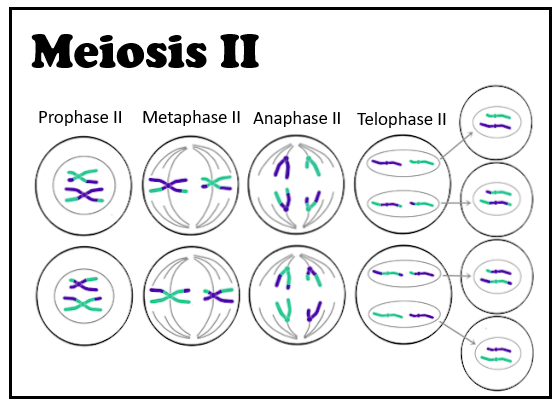Answer
332.9k+ views
Hint: Meiosis is a specialized type of cell division found in special types of cells at a specific period. It is reported in diploid germ cells of the sex organs. In this type of cell division, the cell divides two times.
Complete answer:
In meiosis, After the DNA replication, two rounds of cell division occur to produce four daughter cells with half the number of chromosomes as the original parent cell. These two meiotic divisions are known as meiosis I and meiosis II. Because the number of chromosomes is halved during the meiosis, this allows gametes to fuse forming a zygote containing a mixture of paternal and maternal chromosomes. so, in this way meiosis and fertilization facilitate sexual reproduction with successive generations maintaining the same number of chromosomes.

So, the correct answer is, ‘Maintains the number of the constant chromosome of a particular species.’
Additional Information:
- Meiosis was first demonstrated by Van Benden in 1883 A.D. but was described by Winiwarter in 1900 A.D.
- The term meiosis was given by Farmer and Moore in 1905 A.D.
- Meiosis-I and meiosis-II occur one after another with short or no interphase.
- In meiosis-I, the prophase-I is of the longest duration.
- The four haploid cells produced during meiosis may or may not be of equal size.
- Meiosis-II is also known as equational or homotypical division because the number of chromosomes remains the same as in meiosis-I.
Note: Reproduction without meiosis will result in tetraploidy (4n), while sexual reproduction without fertilization will lead to haploidy in an organism. Meiosis is also known as reductional division because one parent cell produces four daughter cells each having half the number of chromosomes and DNA amount than the normal parental cell.
Complete answer:
In meiosis, After the DNA replication, two rounds of cell division occur to produce four daughter cells with half the number of chromosomes as the original parent cell. These two meiotic divisions are known as meiosis I and meiosis II. Because the number of chromosomes is halved during the meiosis, this allows gametes to fuse forming a zygote containing a mixture of paternal and maternal chromosomes. so, in this way meiosis and fertilization facilitate sexual reproduction with successive generations maintaining the same number of chromosomes.

So, the correct answer is, ‘Maintains the number of the constant chromosome of a particular species.’
Additional Information:
- Meiosis was first demonstrated by Van Benden in 1883 A.D. but was described by Winiwarter in 1900 A.D.
- The term meiosis was given by Farmer and Moore in 1905 A.D.
- Meiosis-I and meiosis-II occur one after another with short or no interphase.
- In meiosis-I, the prophase-I is of the longest duration.
- The four haploid cells produced during meiosis may or may not be of equal size.
- Meiosis-II is also known as equational or homotypical division because the number of chromosomes remains the same as in meiosis-I.
Note: Reproduction without meiosis will result in tetraploidy (4n), while sexual reproduction without fertilization will lead to haploidy in an organism. Meiosis is also known as reductional division because one parent cell produces four daughter cells each having half the number of chromosomes and DNA amount than the normal parental cell.
Recently Updated Pages
How do you arrange NH4 + BF3 H2O C2H2 in increasing class 11 chemistry CBSE

Is H mCT and q mCT the same thing If so which is more class 11 chemistry CBSE

What are the possible quantum number for the last outermost class 11 chemistry CBSE

Is C2 paramagnetic or diamagnetic class 11 chemistry CBSE

What happens when entropy reaches maximum class 11 chemistry JEE_Main

Calculate the volume occupied by 88 gram of CO2 at class 11 chemistry CBSE

Trending doubts
Difference between Prokaryotic cell and Eukaryotic class 11 biology CBSE

Difference Between Plant Cell and Animal Cell

Fill the blanks with the suitable prepositions 1 The class 9 english CBSE

Change the following sentences into negative and interrogative class 10 english CBSE

Give 10 examples for herbs , shrubs , climbers , creepers

What organs are located on the left side of your body class 11 biology CBSE

Write an application to the principal requesting five class 10 english CBSE

What is the type of food and mode of feeding of the class 11 biology CBSE

Name 10 Living and Non living things class 9 biology CBSE



